Vatican Museum
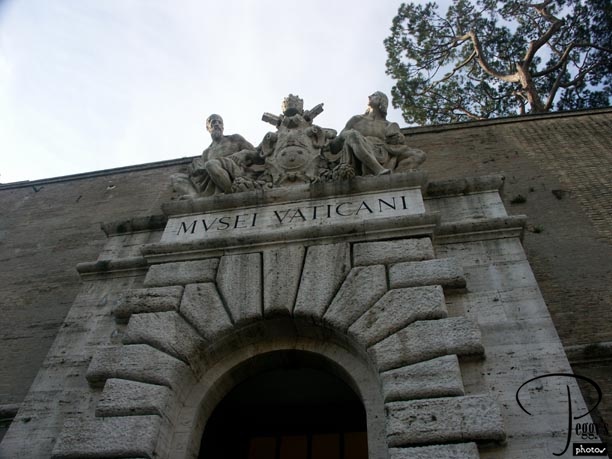
I am back at the Vatican Museum, but today the Sistine Chapel is open. Our tour left our hotel very early in the morning as we were to take a tour of the Vatican Museum before the public was allowed in––tours can visit the museum early, between 8 and 9 a.m. We got a good spot in the line, which moved quickly through the security check. However, our local guide gave us our tickets to enter the museum before we went through the security check––imagine trying to hold onto a ticket while you are taking off your money belt, your coat, your jacket, etc., to put on the X–ray belt. Okay, so everyone else on our tour was able to, but I lost mine. Not my fault––Eddie always held on to our tickets, so this is another thing I now have to learn how to do myself. But I held the tour up as the tour guide had to go back to buy me another ticket. I apologized to them.

Vatican Museum
Vatican Museum
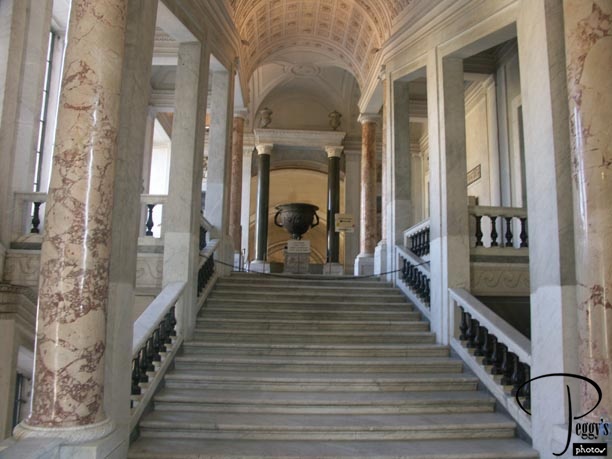
Closed–off section of the Vatican Museum.

Vatican Museum
Vatican Museum
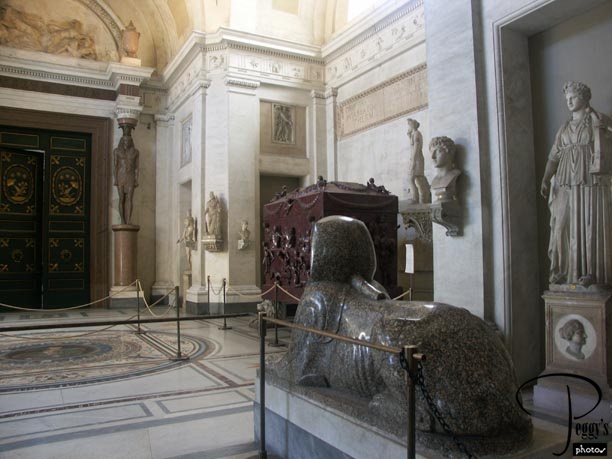
More Vatican treasures. As I already have put a slide show of the Vatican Museum on this site, I won’t put any more photos of it on this album. Go to Slide Shows, Western Europe, Italy–1, “Rome: Vatican Museum.”

Vatican Museum
On Way to the Sistine Chapel
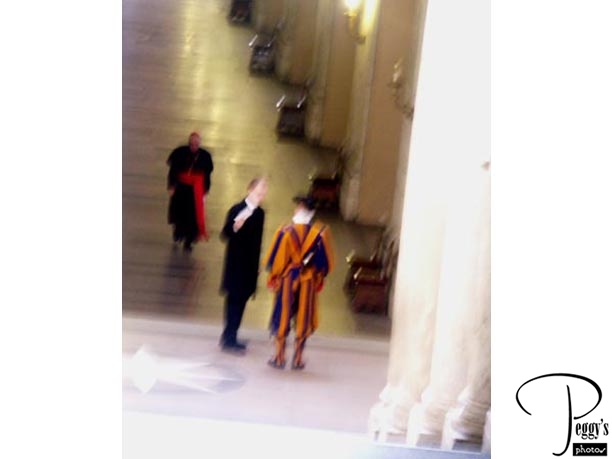
I caught this photo of a Roman Catholic Cardinal (I assume that he is a cardinal by the color of his hat) and of a Swiss Guard on the way to the Sistine Chapel. The Swiss Guards guard the Vatican.

On Way to the Sistine Chapel
On the Way to St. Peter’s Basilica
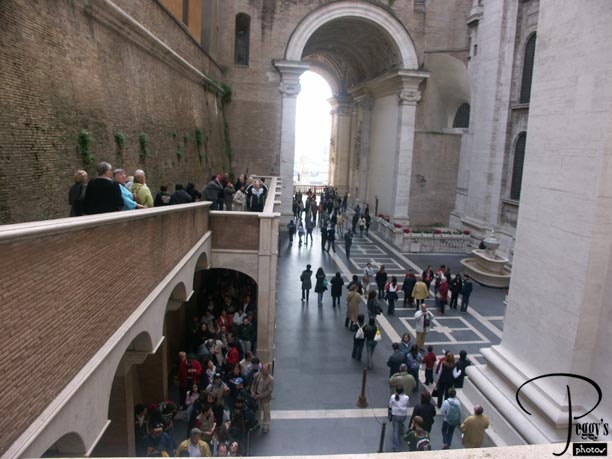
No phototaking was allowed in the Sistine Chapel. However, there are a number of Internet sites where you can find photos of it. The Sistine Chapel is a large rectangular building with its ceiling painted by Michelangelo. It is a depiction of the world before Christ. It was awe–inspiring. This photo shows the shortcut that we took from the Sistine Chapel to St. Peter’s––if you can’t find this shortcut, you have to walk back through the Vatican Museum and then along the Vatican Wall until you get to St. Peter’s Square––a long walk. The people in line in the photo are waiting to see the tomb of Pope John Paul II.

On the Way to St. Peter’s Basilica
St. Peter’s Basilica
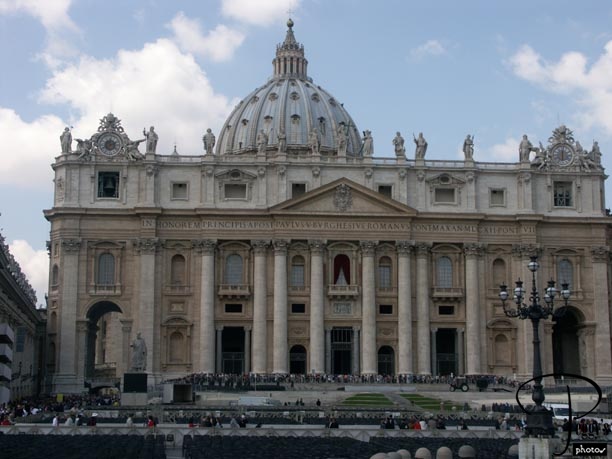
You can see the line to enter the basilica in the photo. We joined the end of the line farther down in St. Peter’s Square. It didn’t take too long to arrive at the front entrance via another trip through security. I already put a slide show on this site of St. Peter’s Basilica so I won’t add any more photos of it here.

St. Peter’s Basilica
Swiss Guards
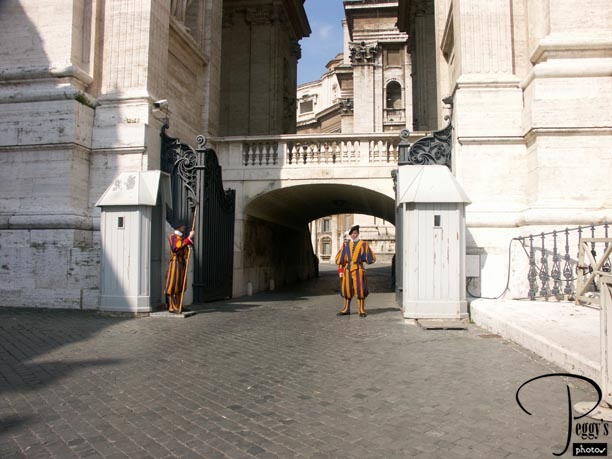
A photo of the Swiss Guards guarding one of the entrances to the Vatican. Originally, all the Swiss Guards had to be born Swiss, but today they can be of other nationalities as well. They have to be Roman Catholic, unmarried, between the ages of 18 and 25, and good–looking (that last one for real according to an Internet site!).

Swiss Guards
Swiss Guards
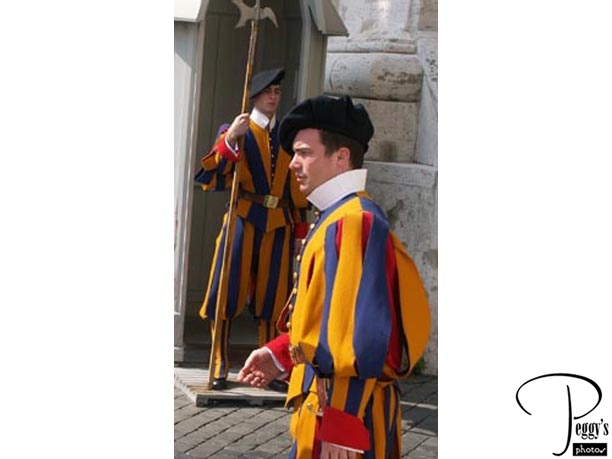
Close–up of the Swiss Guards.

Swiss Guards
On the Way to the Colosseum
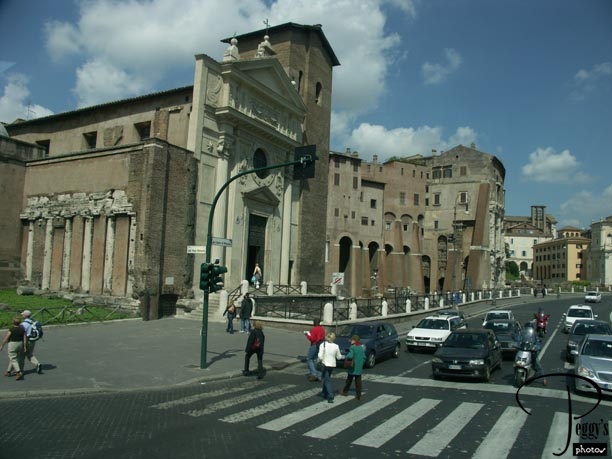
On the way to the Colosseum, we passed the St. Nicholas in Carcere (St. Nicohlas in Prison) Church. It was built in the ruins of three temples (Spes, Juno, and Janus) and the ancient Forum Olitorium. The columns are from the Temple of Juno Sospita, built in 3 A.D. The temples were later converted into a prison. The church was built in 1599 and restored in the 19th century. The church is also known as the Church of Petrus Leonis after a Jewish family who converted to Christianity.

On the Way to the Colosseum
On the Way to the Colosseum
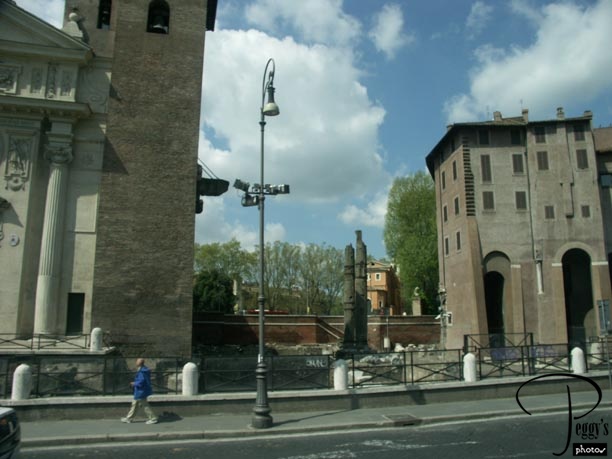
Excavation pit of Roman ruins on the other side of the church. The columns probably belonged to the Temple of Juno Sospita.

On the Way to the Colosseum
Another Colosseum
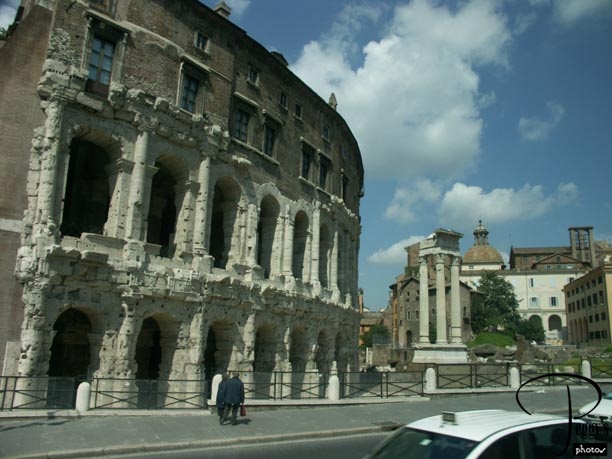
Not the famous Colosseum and not the Forum, but another colosseum and more Roman ruins that we saw on our way. This is the Theatre of Marcellus, which became the family fortress of Petrus Leonis, the Jewish family who converted to Christianity. It later became a theater for the performing arts.

Another Colosseum
Rolex for Sale

Interesting building to be housing a Rolex store.

Rolex for Sale
St.-Peter’s-in-Chains Church
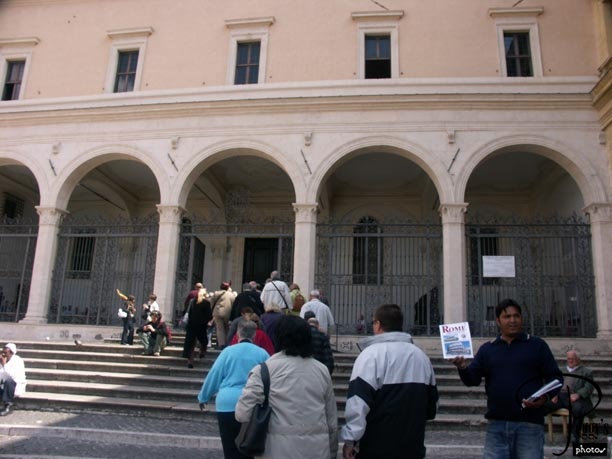
We had an optional tour to visit the St.–Peter’s–in–Chains Church along with the Catacombs, the Appian Way, Caracalla’s Baths, etc. A trip to the Colosseum was part of the regular tour, but those of us who were going on the optional tour first visited St.–Peter’s–in–Chains Church before visiting the Colosseum so that we would be able to visit it before it closed for its afternoon break (which I ran into yesterday). This photo shows our group entering St.–Peter’s–in–Chains Church. The church was founded in 440 to house St. Peter’s chains but the church was redone in 1475.

St.-Peter’s-in-Chains Church
St.-Peter’s-in-Chains Church
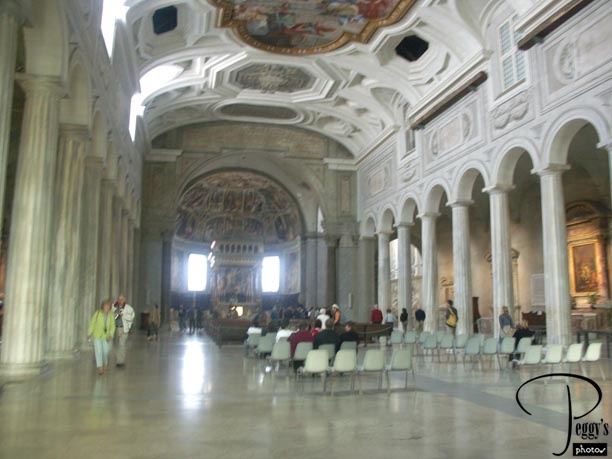
Inside the church. The columns shown here are the original columns are from the 440 B.C. church.

St.-Peter’s-in-Chains Church
Michelangelo’s Moses
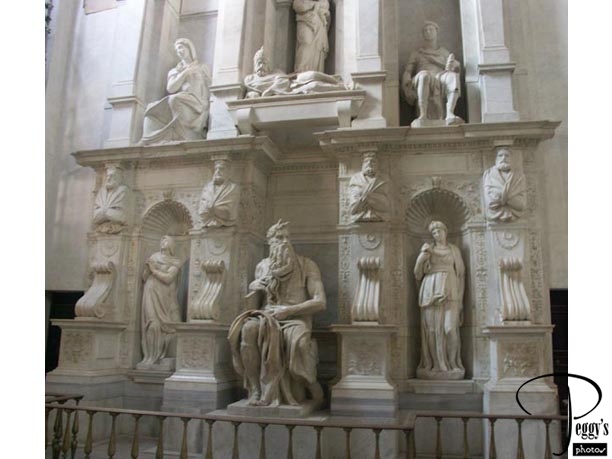
These statues are in this church. Here, Michangelo’s Moses has horns, which derives from a translation error––in Hebrew, the word for “halo” was mistranslated to be “horns.” It is said that Michelangelo knew a mistake had been made, but went with the horns anyway to make Moses kind of scary.

Michelangelo’s Moses
St.-Peter’s-in-Chains Church
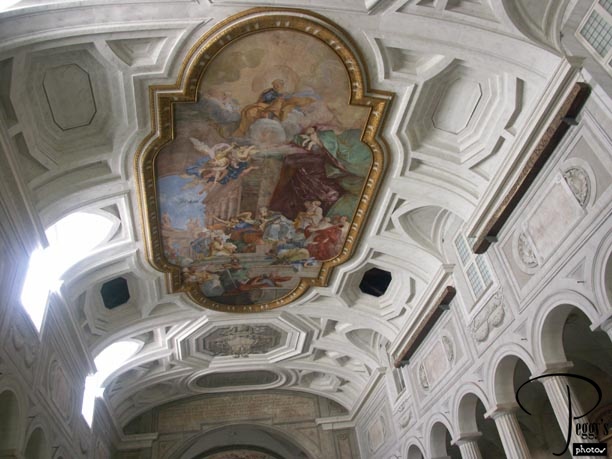
Ceiling of the church.

St.-Peter’s-in-Chains Church
St.-Peter’s-in-Chains Church
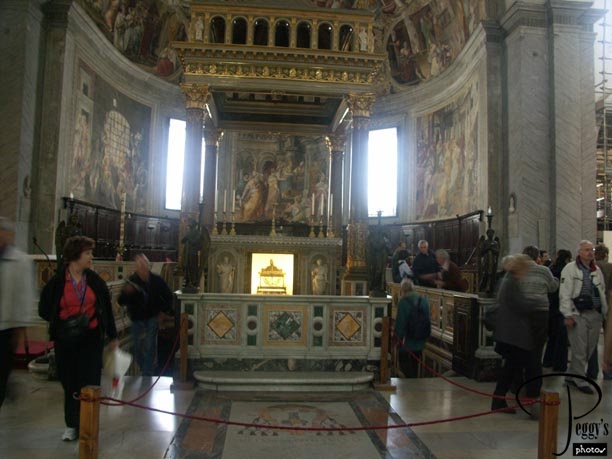
The chains. There are two sets of chains linked together here behind a glass shield. One set held Peter when he and Paul were prisoners in Rome’s Mamertine Prison. The other set held Peter when he was jailed in Jerusalem. An angel appeared at the Jerusalem prison and the chains fell off and Peter escaped. In the last days of Ancient Rome, the latter chains were a gift from an Eastern empress. Both sets of chains were put next to each other and they miraculously joined together, proving that both chains had actually held Peter.

St.-Peter’s-in-Chains Church
The Chains
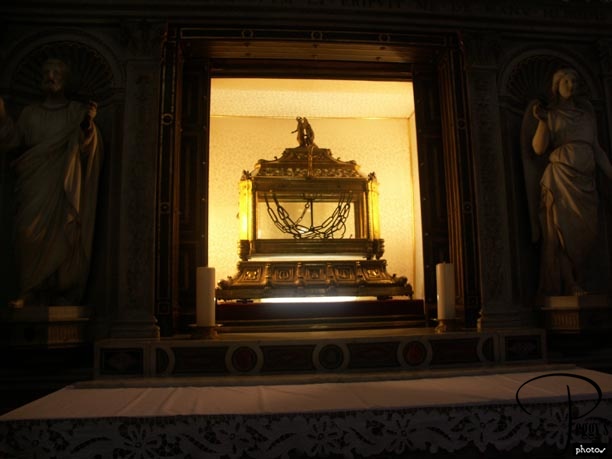
Closer–up view of the chains.

The Chains
The Chains
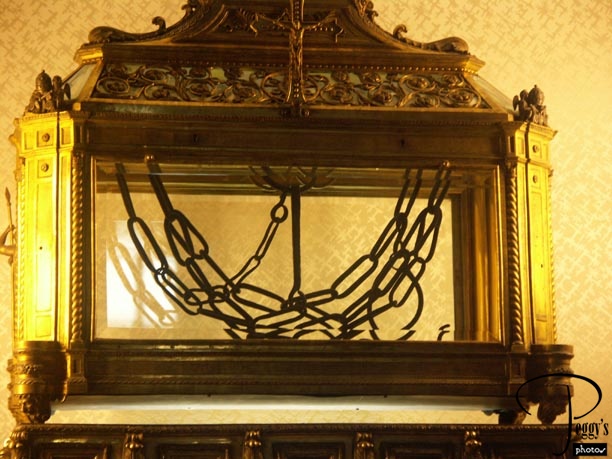
Closer–up view of the chains.

The Chains
Mass
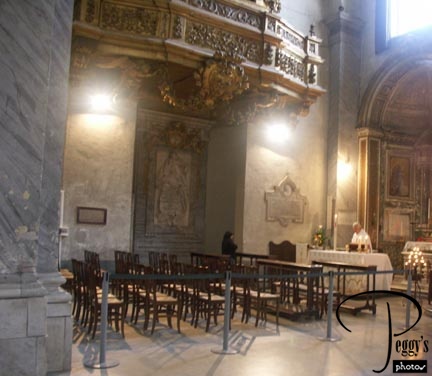
Mass being celebrated at St.–Peter’s–in–Chains Church.

Mass
Inside the Church
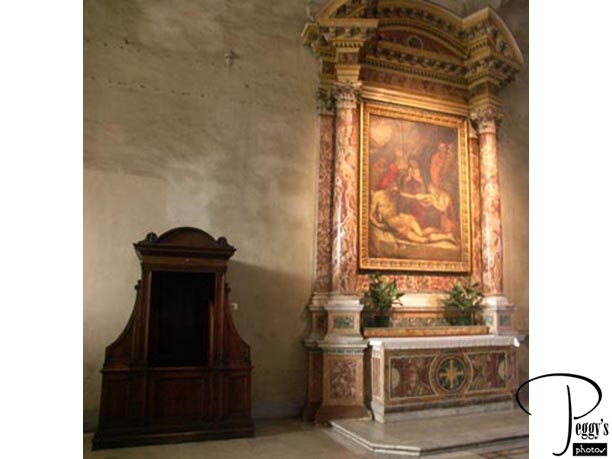
Painting inside the church.

Inside the Church
St.-Peter’s-in-Chains Church
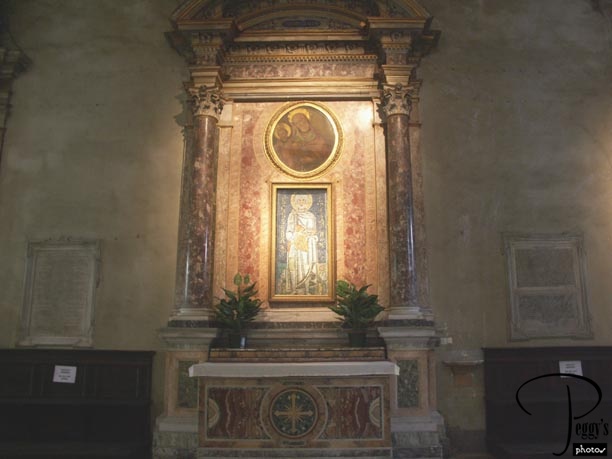
Art work inside the church.

St.-Peter’s-in-Chains Church
Colosseum
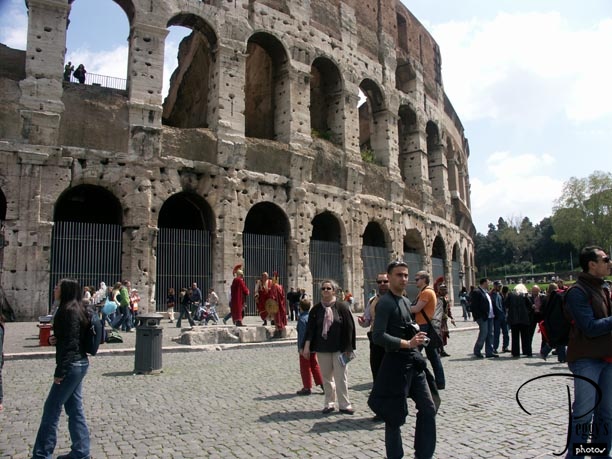
I’m back again at the Colosseum. We were given a short tour around the Colosseum and then it was time for lunch. I ate with the sisters at a small outside restaurant on one the side of the entrance to the Metro station, in full view of the Colosseum. I think that I had pizza, which was very good.

Colosseum
Roman Gladiators and Citizen
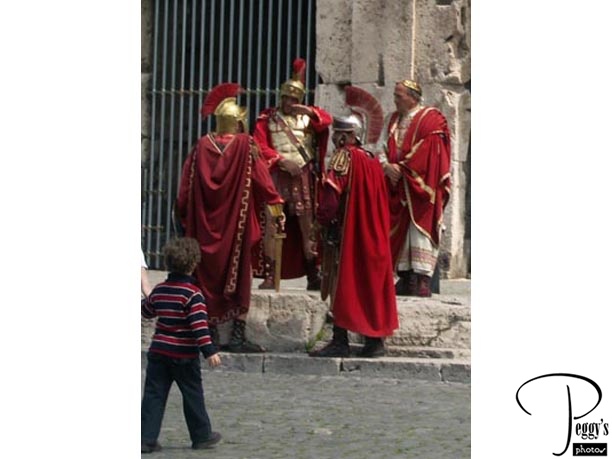
I took this photo of these Roman gladiators and a Roman citizen on the sly.

Roman Gladiators and Citizen
Seen from the Bus
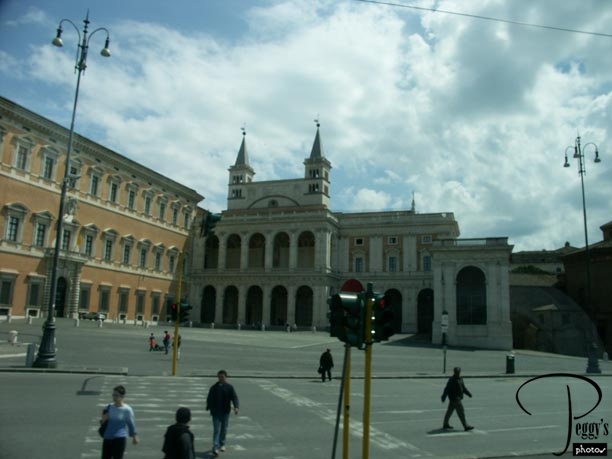
We went back on our Trafalgar bus to head to the Catacombs. We passed these buildings along the way.

Seen from the Bus
Another Building
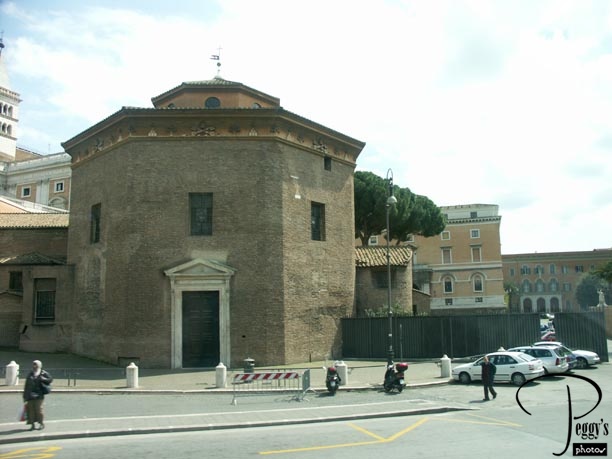
We also passed this interesting building.

Another Building
Along the Appian Way
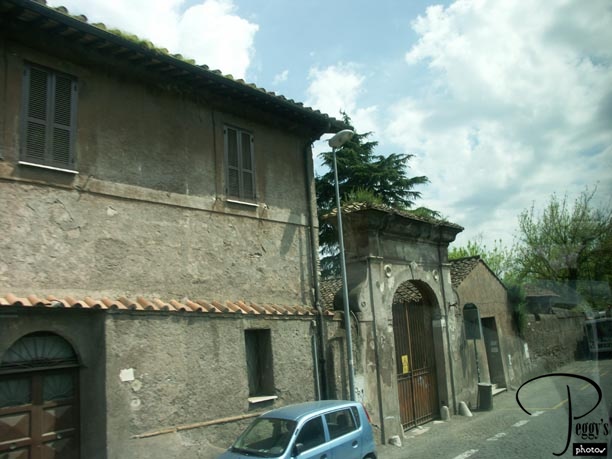
To reach the Appian Way, we first passed through the San Sebastian Gate. I was on the wrong side of the bus to take a photo of it (we changed seats on the bus everyday, so sometimes you were on the right side to get a photo and sometimes you weren’t). The gate and the Appian Way are very interesting sights and Rome travel books recommend that you take a walk along the Appian Way. We saw some old taverns and ruins dating back to ancient times. The Appian Way was begun in 312 B.C. First, it connected Rome to Naples and then Rome to the Adriatic, and then other cities, for a total of 350 miles.

Along the Appian Way
Catacombs
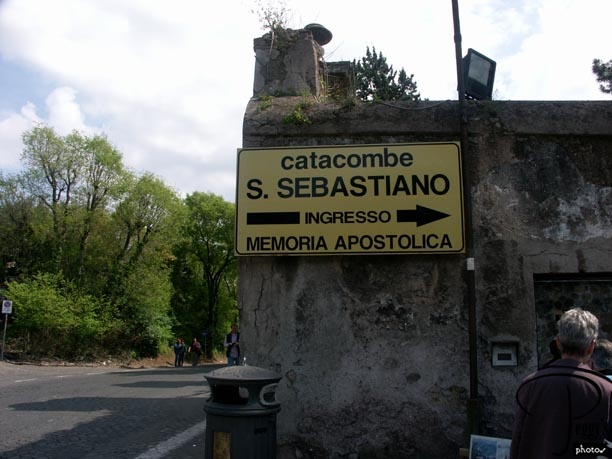
We next visited the San Sebastian Catacombs.

Catacombs
San Sebastian Church
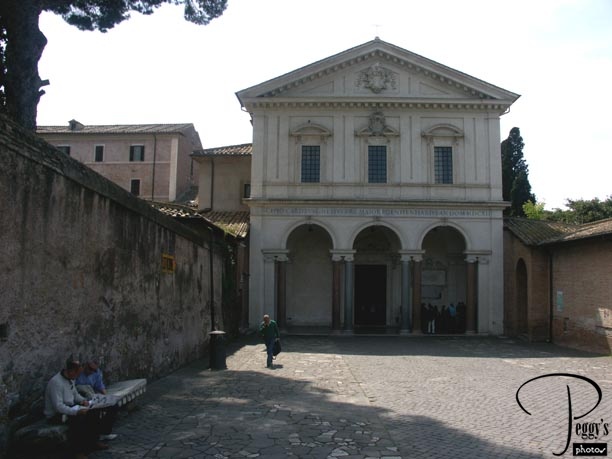
The San Sebastian Church was actually built above the Catacombs in the 17th century.

San Sebastian Church
San Sebastian Church
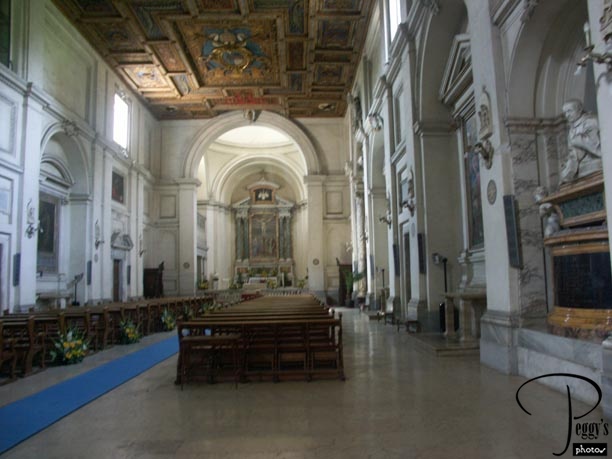
We first toured the church with the help of a local guide. The photo is of the inside of the church.

San Sebastian Church
San Sebastian Church
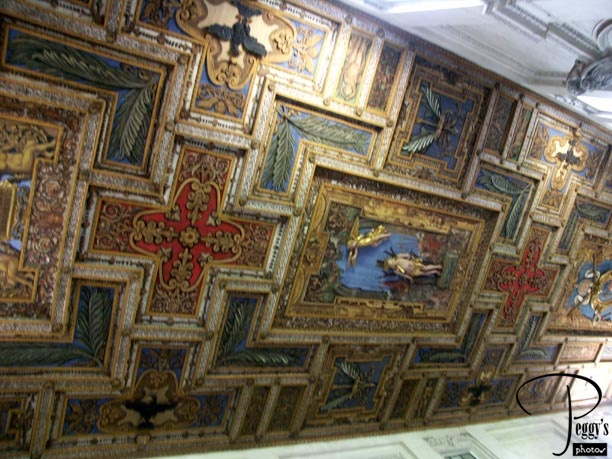
The ceiling of the church.

San Sebastian Church
San Sebastian Catacombs
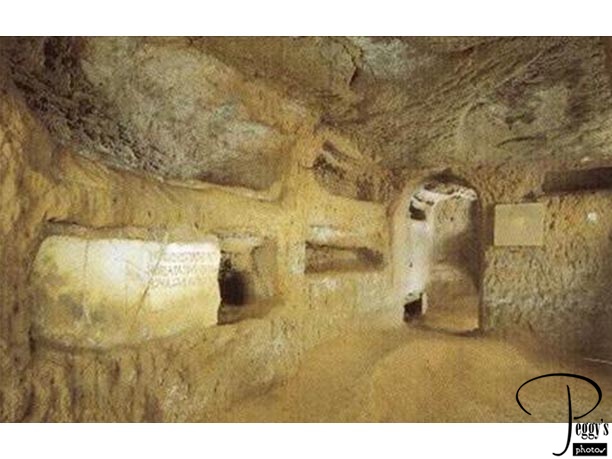
We entered the catacombs from inside the church. It was almost like being inside a gold mine with passageways and tunnels on different levels. The Catacombs: No burials were allowed in the city of Rome, so the Christians began burying their dead underground outside of Rome. The bodies were placed in niches that were cut out of underground soil. The soil here is very easy to dig, but when exposed to air becomes very hard. The Christians did not use the Catacombs to hide in, although it would have been very easy to do this. No photos were allowed inside the Catacombs, so I bought some postcards and have scanned them. This postcard shows the niches and a passageway.

San Sebastian Catacombs
San Sebastian Catacombs
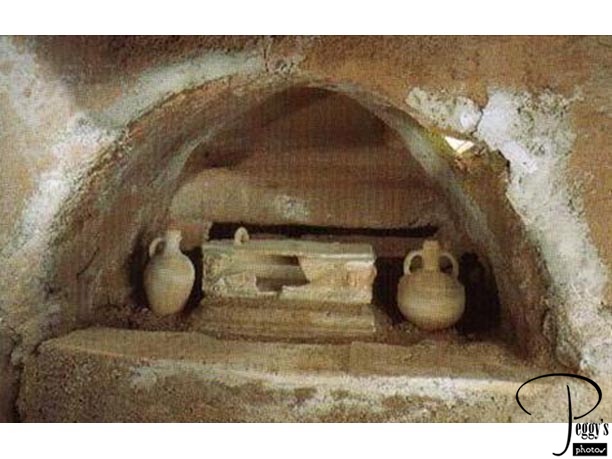
Another burial niche.

San Sebastian Catacombs
San Sebastian Catacombs
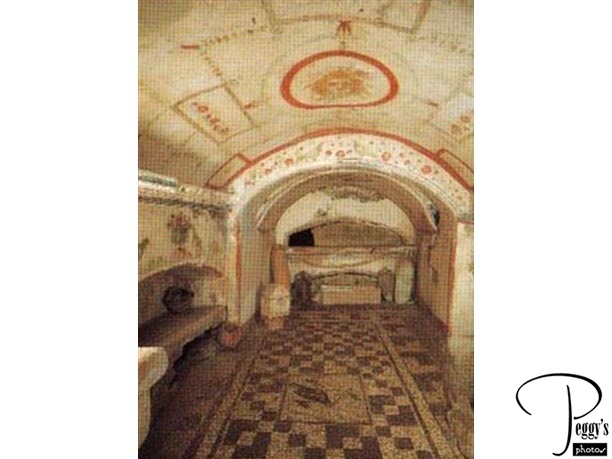
The area near the catacombs also had Roman burial tombs. We could actually see the bottom of the floor of the church while we were viewing some of the Roman burial sites. The Roman cremated their dead and put their ashes into urns. This postcard show a Roman burial site.

San Sebastian Catacombs
San Sebastian Catacombs
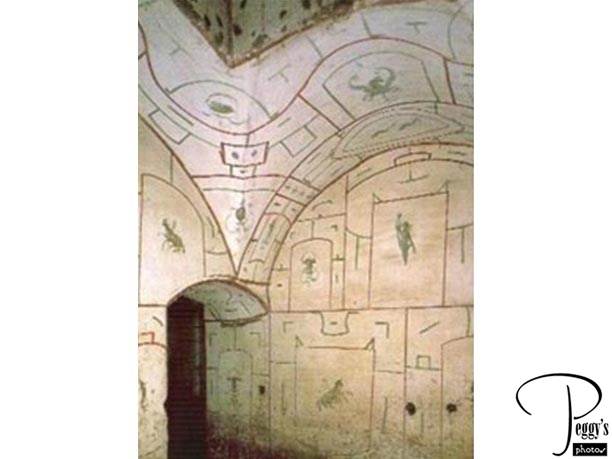
Drawings on a Roman burial site.

San Sebastian Catacombs
Roman Pyramid
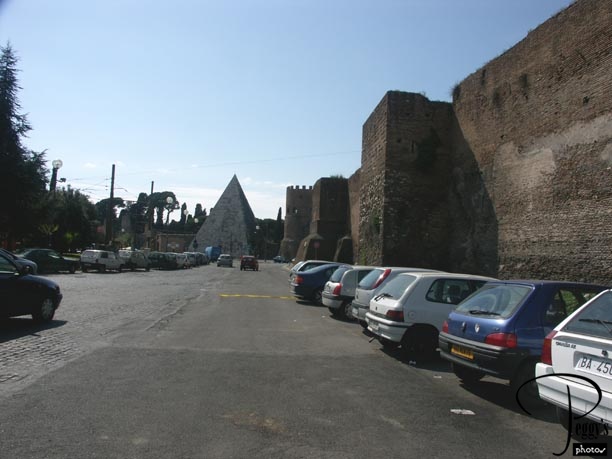
On our way back to Rome on the Appian Way, we passed the ruins of Caracalla’s Baths, a huge complex of old Roman baths. This is something you may want to explore on your Appian Way walk. Also, you may want to stop at the Church of Domine Quo Vadis? (the question mark is part of the church’s name). This is where St. Peter was said to have met Christ when he was fleeing from Rome. We stopped to look at the pyramid of Calius Cestius. He was a weathly Roman who built this pyramid as his and his family’s tomb. Cestius died in 12 B.C. The pyramid is 188 feet high and took 330 days to build.

Roman Pyramid
Pyramid of Calius Cestius
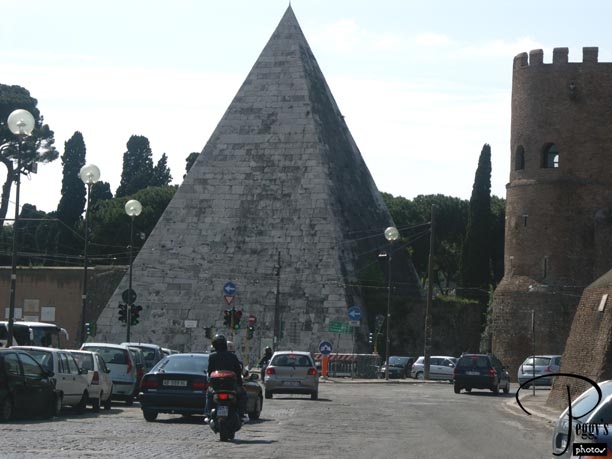
Close–up of the pyramid.

Pyramid of Calius Cestius
View from the Bus
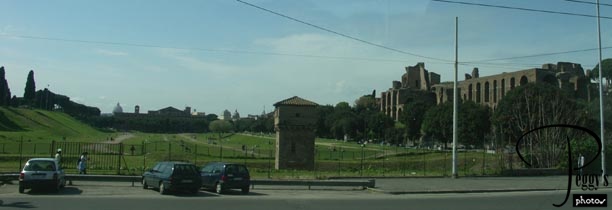
A view of the Circus Maximus and Palatine Hill. We went back to our hotel and were given a short time to rest before we were to go on our nightime adventure.

View from the Bus
Via Veneto

Tonight, there was an optional tour to the Trevi Fountain and for an Italian Style Dinner with Drinks and Music. I went on it. We got back on our bus and passed the Via Veneto. Then we got off the bus and walked to the Trevi Fountain (my fourth time there). It was very crowded and I didn’t take any new photos of it as I had to rethrow a coin into the fountain. Paolo told us the correct way to do this and I had done it wrong the first time. You must have your back to the fountain and throw your coin over your right shoulder. If you do it wrong, you won’t then come back to Rome. It took quite a lot of manuvering among the crowd to get close enough to the fountain to throw my coin, but I did it.

Via Veneto
Spanish Steps
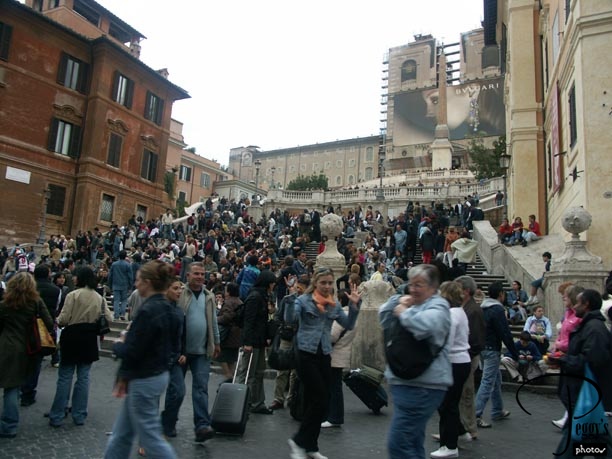
Remember the photos I already put on this site of the Spanish Steps at the Piazza di Spagna? Here is a photo of them on a Saturday night––mobbed with people (tourists?).

Spanish Steps
Piazza di Spagna
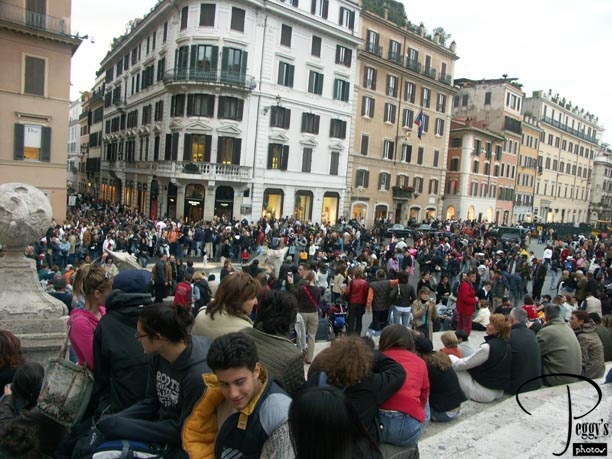
And a view of the Piazza di Spagna from the Spanish Steps. Our instructions from Paolo were to walk from here to the Piazza del Popolo––down the street a way. By this time, I knew where to go and where I was going. This felt like I was finally getting to know my way around Rome––a good feeling.

Piazza di Spagna
Lost Gladiator
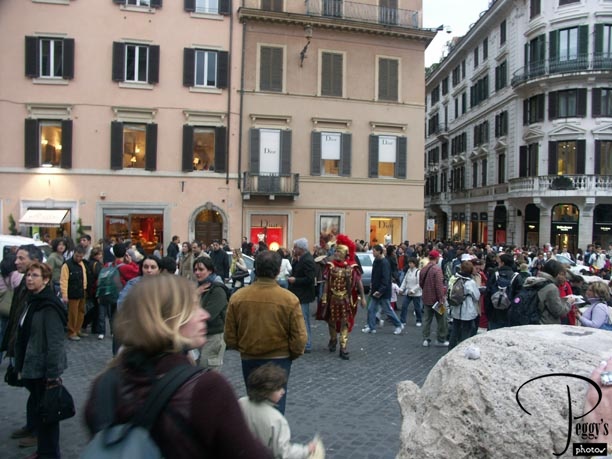
I think this gladiator had lost his way––Wasn’t he supposed to be at the Colosseum?

Lost Gladiator
On Our Way to Piazza del Popolo
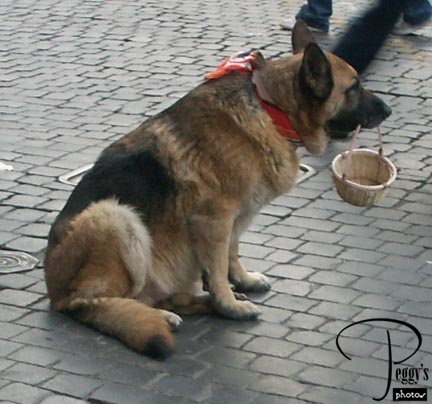
This poor dog was begging on the street for euros. He does look well fed.

On Our Way to Piazza del Popolo
On Our Way to Piazza del Popolo
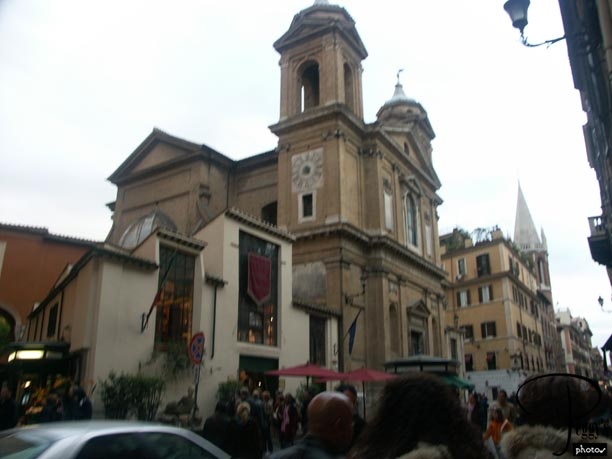
Buildings passed on our way.

On Our Way to Piazza del Popolo
Canova Restaurant
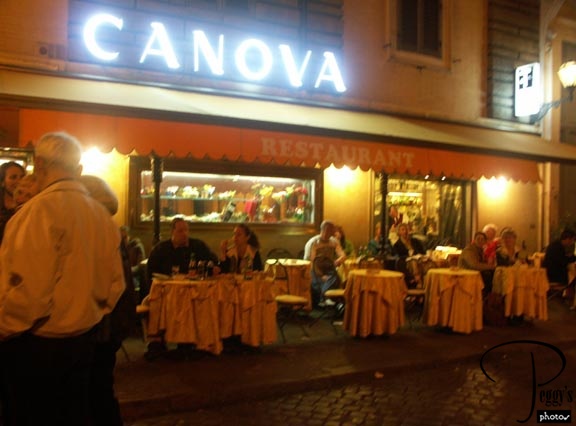
We had our Italian dinner here, complete with music. This I recognized as the restaurant where I had eaten lunch a few days ago. Paolo told me that it was a famous restaurant. Wine was included and our group, perhaps, got a bit overspirited––not me, as I prefer to watch and I busied myself by making some movie clips of the event––for posterity! Go to Movies, Western Europe, Italy, “Tour Group at Canova Restaurant–1, –2, and –3.”
